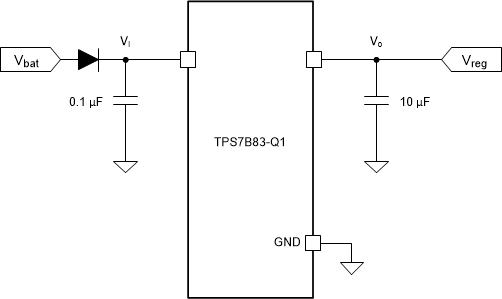SBVS376 November 2020 TPS7B83-Q1
PRODUCTION DATA
- 1 Features
- 2 Applications
- 3 Description
- 4 Revision History
- 5 Pin Configuration and Functions
- 6 Specifications
- 7 Detailed Description
- 8 Application and Implementation
- 9 Power Supply Recommendations
- 10Layout
- 11Device and Documentation Support
- 12Mechanical, Packaging, and Orderable Information
Package Options
Mechanical Data (Package|Pins)
- DCY|4
Thermal pad, mechanical data (Package|Pins)
- DCY|4
Orderable Information
8.2 Typical Application
Figure 8-4 shows a typical application circuit for the TPS7B83-Q1. Use different values of external components, depending on the end application. An application may require a larger output capacitor during fast load steps in order to prevent a reset from occurring. TI recommends a low-ESR ceramic capacitor with a dielectric of type X5R or X7R.
 Figure 8-4 Typical
Application Schematic for the TPS7B83-Q1
Figure 8-4 Typical
Application Schematic for the TPS7B83-Q1